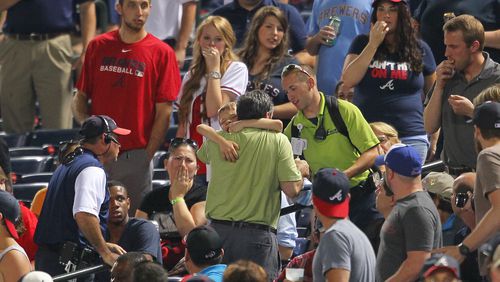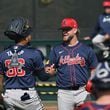Foul balls by the numbers
- At the Aug. 30, 2010, game in which a 6-year-old girl was seriously injured, Turner Field's safety netting protected 2,791 seats (out of a capacity 49,586 seats) from the risk of balls or bats entering the stands behind home plate, court filings say.
- The best sections for fans to catch foul balls at Turner Field are sections 113 through 124, with sections 113-118 also being good for catching tossed balls from players, according to bestfoulballseats.com.
- A 2003 study about medical care that's required for mass gatherings estimated that injuries from foul balls at Major League Baseball games happen to 35.1 out of every 1 million fans who attend a game.
- Since 1862, 120 spectators have died from foul ball injuries, 47 spectators have died from thrown baseball injuries and 43 spectators have died from bats that entered the stands, said Robert Gorman, co-author of "Death at the Ballpark."
The foul ball sliced into the seats behind the Atlanta Braves dugout and rocketed into the head of an 8-year-old boy.
On the mound, pitcher Julio Teheran collapsed into a crouch, clasping his head with his hands. The batter, Milwaukee Brewers’ outfielder Carlos Gomez, knelt, bowed his head and made the sign of the cross. Play was briefly suspended, and the TV cameras followed the boy’s father as he carried the stricken child out of the stands.
“It was fast and hard,” Teheran said of the line-drive foul that struck the young fan May 20. “No one had a chance to get out of the way.”
The field-level seats behind each dugout at Turner Field can be dangerous territory, particularly when a major league hitter fouls a line drive at 90 mph into the crowd. (An engineering professor who testified in a Boston Red Sox case said the foul ball that struck a woman in the face went from bat to fan in one second.)
Like other teams, the Braves have declined to extend the safety netting behind home plate farther down the foul lines. In court filings, the team cites an obvious truth: many fans don’t like sitting behind netting that obstructs their view. In addition, the team argues, spectators know they’re assuming some risk, and many opt for field-level seats for the very reason that a foul or tossed ball might come their way.
But now the team is in the middle of a lawsuit filed by the father of a 6-year-old girl whose skull was shattered by a foul ball. The suit says the team should be held liable for failing to extend the netting. In response, the Braves have asked the Georgia Court of Appeals to apply the so-called “Baseball Rule.”
The rule, already in force in other states, says if a stadium operator provides screening behind home plate – the most dangerous place in the stands – and enough seats for spectators who want to sit there, it cannot be held liable for balls and bats that enter the stands and cause injuries.
‘All risk and danger incidental to baseball’
The suit was brought by a man who’d taken his 6-year-old daughter to a May 30, 2010, game at Turner Field. During one at bat, Braves outfielder Melky Cabrera slashed a liner behind the third-base dugout that struck the girl in the forehead, fracturing her skull in 30 places and causing traumatic brain injury.
The girl’s parents believe extended netting should have already been in place, given the number of injuries in seats behind the dugouts, their lawyer, Mike Moran, said. “These incidents, like the recent one involving the young boy, will continue to happen unless something is done about it.”
“The ‘Baseball Rule’ is literally and figuratively an archaic rule,” Moran added. “The game has changed. The players are bigger and stronger. The rule is just not sufficient to protect the fans.”
The Braves would not identify the boy who was struck recently and declined to disclose the progress of his recovery. The team also declined to answer questions for this article, citing the pending litigation.
The back of all major league baseball tickets provides a warning that tells fans they assume “all risk and danger incidental to the sport of baseball,” including the danger of being injured by thrown or batted balls and thrown or broken bats. Teams also flash warnings on scoreboards during games, telling fans to stay alert.
Such warnings, however, may not apply to children.
In 1984, the state Court of Appeals declined to dismiss a lawsuit filed on behalf of an 8-year-old boy whose teeth were knocked out when he was struck by a foul ball at Atlanta-Fulton County Stadium. The case settled before going to trial.
“A child that young can’t assume the risk,” the boy’s lawyer, Robert Nardone, said.
‘Facts known to every person who watches a game’
The Braves are now appealing a ruling by a Fulton County State Court judge who declined to dismiss the lawsuit brought on behalf of the 6-year-old girl.
The Atlanta Journal-Constitution knows the identity of the girl but is withholding her name at the family’s request. The lawsuit only identifies the child and her father by their initials.
The office of Major League Baseball’s Commissioner, Bud Selig, is asking the Court of Appeals to grant the Braves’ request for the “Baseball Rule.”
“The Baseball Rule takes account of two facts inherent about baseball, facts known to every person who watches a game,” Thomas Ostertag, MLB’s senior vice president and general counsel, told the court.
The first is that the sport carries ordinary risks for spectators, such as being injured by balls and bats. Second, stray balls are part of the fabric of the game and are far from being an unwelcome hazard, Ostertag said.
“Indeed, few have watched an MLB game without hoping that they would catch a home run or foul ball,” he said.
Without the “Baseball Rule,” stadium owners face a Hobson’s choice: they could screen the entire field and lose fans, or they could continue providing unscreened areas and pass on the cost of liability judgments to fans by increasing ticket prices, Ostertag added.
The Braves’ court filing said another result of not having the rule could be restricting where families with children and where disabled individuals can sit.
‘Spectators aren’t always paying attention’
Baseballs are traveling as fast as ever. Last year, 16 major league pitchers — some doing it multiple times — reached at least 100 miles an hour on their fastballs. And squared-up batted balls are whistling out of the batter’s box at almost equally high speeds.
In litigation involving a woman struck by a foul ball at a Boston Red Sox game more than a decade ago, Northeastern University engineering professor Ronald Mourant watched video of the play, went to Fenway Park to take measurements and then did the physics calculations. His findings: the ball was traveling 90 miles an hour when it slammed into the woman’s face, just 1.07 seconds after it left the bat.
Robert Gorman, co-author of “Death at the Ballpark,” which chronicles fatalities at baseball games on all levels of competition — from Little League to Major League — said more fans are being injured than most people realize.
“Baseball gets its protection based on a premise that I believe is false: The fans know how dangerous the game is,” Gorman said. “But the problem is they don’t. And there are so many distractions during games, spectators aren’t always paying attention to the field.”
Gorman’s book, published in 2008, said about 80 spectators died from foul balls, thrown balls and bats from 1862 to 2007. But Gorman is now putting together a second edition because additional research uncovered 210 such fatalities.
Over the years, baseball has adopted a number of safety measures. It has required batters to wear helmets and, after a first base coach died in 2007 after being struck in the head with a foul ball, required on-field coaches to wear helmets too. Teams have also put up netting in front of dugouts.
“It’s always about protecting the players,” Gorman said. “Not the fans.”
About the Author







